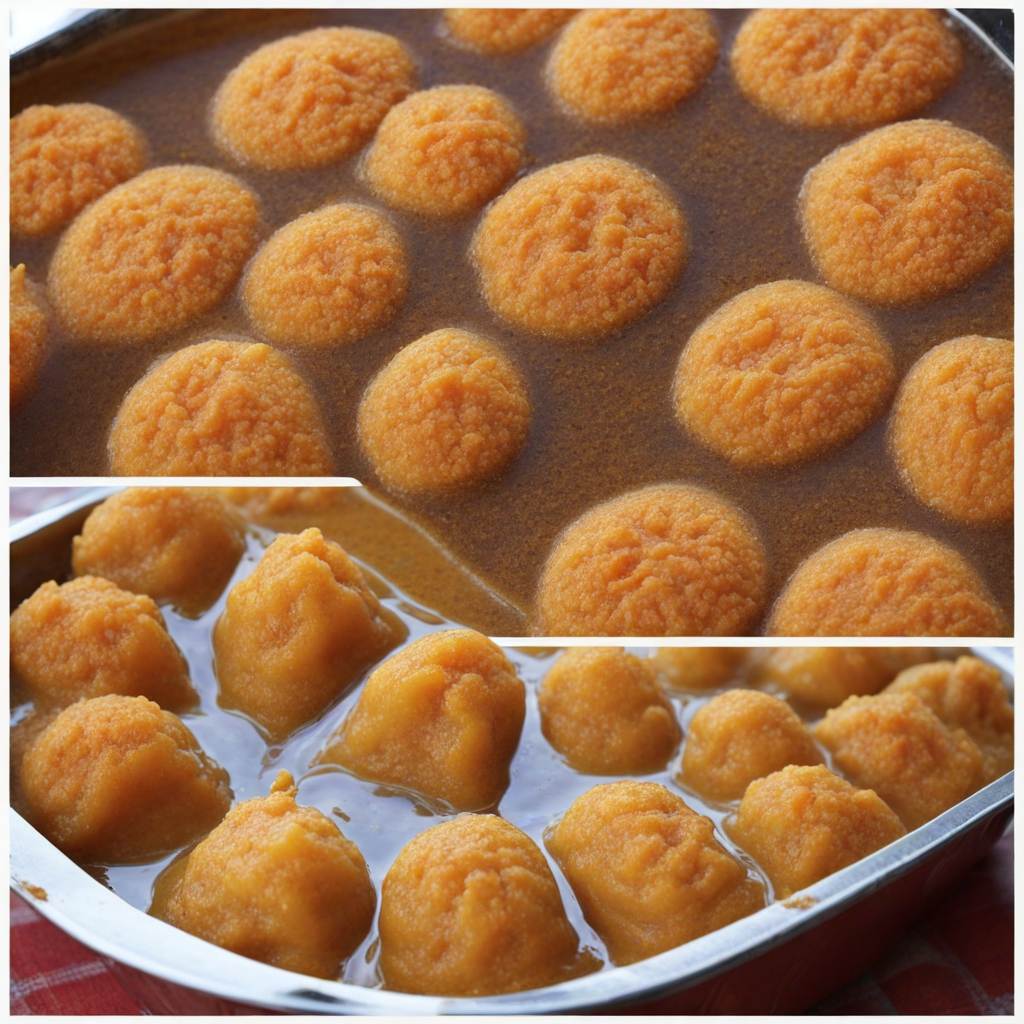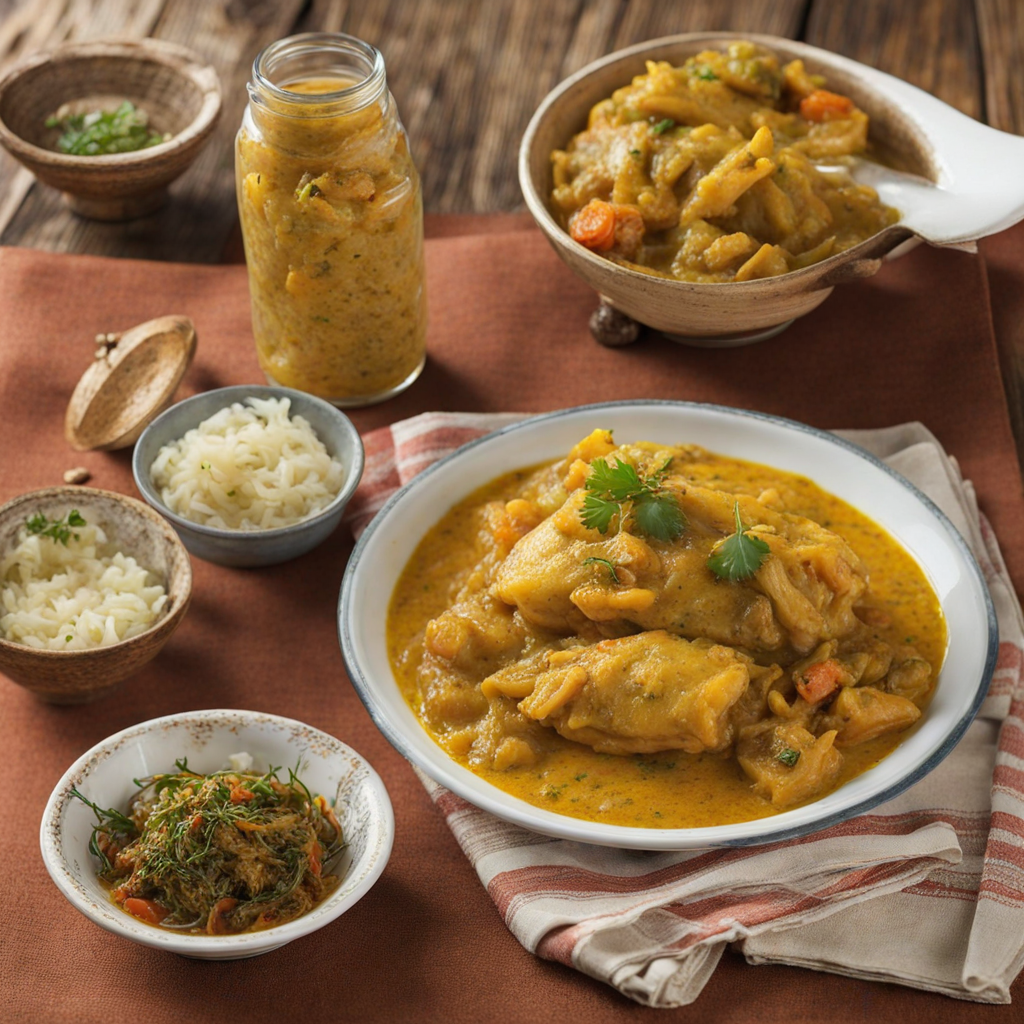Bobotie
Bobotie is a traditional South African dish that beautifully marries the flavors of the Cape Malay cuisine. This unique dish features a base of spiced minced meat, typically beef or lamb, which is mixed with a medley of ingredients such as onions, garlic, and a variety of spices like curry powder, turmeric, and cumin. The addition of dried fruits, such as apricots or raisins, introduces a subtle sweetness that balances the savory elements, creating a complex flavor profile that is both comforting and exotic. The meat mixture is then topped with a custard-like layer made from eggs and milk, which bakes to a golden, slightly tangy finish. The preparation of Bobotie involves a delightful layering of tastes and textures, with the spiced meat providing a hearty foundation while the egg topping adds a creamy richness. Often served with a side of yellow rice, which is typically flavored with turmeric and sometimes accompanied by chutney or sambal, Bobotie offers a well-rounded meal that is both satisfying and packed with flavor. The dish can be garnished with sliced almonds or bay leaves, adding a touch of elegance to its presentation. Bobotie is not just a dish; it embodies South Africa's rich cultural tapestry and history, having been influenced by various culinary traditions over centuries. Its unique combination of sweet and savory elements makes it a standout choice for those looking to explore new tastes. Whether enjoyed at a family gathering or in a cozy restaurant, Bobotie promises a delicious adventure that invites you to savor the essence of South African cuisine.
How It Became This Dish
The Enigmatic Bobotie: A Journey Through South African Culinary History Bobotie is more than just a dish; it is a symbol of South Africa's rich cultural tapestry, a culinary testament to centuries of blending, adaptation, and resilience. This delectable meal, characterized by its spiced minced meat topped with a creamy egg custard, has roots that stretch back to the very fabric of the nation’s history, intertwining the influences of indigenous peoples, colonial powers, and the diverse communities that populate the country today. #### Origins of Bobotie The origins of bobotie can be traced back to the 17th century in the Cape Colony, where the Dutch East India Company established a foothold in Southern Africa. The dish is thought to have been inspired by the Indonesian dish "bobotie," which consists of minced meat, spices, and a custard topping. The arrival of the Cape Malays, who were brought to South Africa as slaves from the East Indies, introduced a wealth of culinary practices that would significantly shape the local cuisine. The term "bobotie" itself may derive from the Malay word "bobotok," a dish made with spiced meat. Dutch colonists adopted and adapted the recipe, incorporating local ingredients and flavors. The use of curry spices, dried fruits, and nuts showcases the melding of flavors from the Indian subcontinent, Middle Eastern, and indigenous African culinary traditions. #### Cultural Significance Bobotie carries profound cultural significance within South African society. It is often regarded as the national dish, celebrated for its unique blend of flavors and textures. The dish is a staple at social gatherings, family celebrations, and festive occasions, symbolizing comfort and togetherness. As a reflection of South Africa's multicultural identity, bobotie serves as a culinary bridge, connecting diverse communities through shared traditions. The preparation of bobotie is often a communal activity, where family members come together to cook, share stories, and pass down recipes. This practice fosters a sense of unity and continuity, linking generations through the art of cooking. Bobotie also features prominently in various cultural narratives, representing resilience and adaptation amid historical challenges faced by the South African people. #### Development Over Time As South Africa evolved through the colonial era into the apartheid period and beyond, so too did bobotie. The dish has undergone numerous transformations, adapting to changing tastes, availability of ingredients, and cultural influences. In the early days, the dish was primarily made with mutton or beef, but as South Africa's culinary landscape diversified, so did the ingredients. Today, bobotie can be made with chicken, lamb, or even vegetarian substitutes, reflecting a growing awareness of dietary preferences and health considerations. The introduction of mass-produced condiments and spices in the 20th century altered the way bobotie was prepared. While traditional recipes still emphasize the use of spices such as curry powder, turmeric, and coriander, modern adaptations may include commercially available spice blends that simplify the cooking process without compromising flavor. This evolution illustrates the adaptability of bobotie, as it continues to resonate with contemporary palates while preserving its historical essence. Bobotie's rich history is also intertwined with the socio-political landscape of South Africa. During the apartheid era, the dish became a symbol of resistance and cultural pride among marginalized communities. Cookbooks and culinary publications began to celebrate traditional dishes like bobotie, asserting the importance of preserving South African heritage amidst the forces of globalization. This resurgence of interest in traditional recipes allowed for a revival of pride in local ingredients and cooking methods, ultimately enriching the culinary landscape of the nation. #### The Ingredients and Cooking Techniques Bobotie is distinguished by its complex layers of flavor, achieved through the careful selection of ingredients. The base consists of minced meat, typically mixed with breadcrumbs soaked in milk or stock, which helps create a tender texture. The incorporation of dried fruits such as apricots or raisins infuses a subtle sweetness that balances the savory elements of the dish. Spices play a crucial role, with curry powder being the most prominent, often complemented by turmeric, ginger, and cloves. The topping of bobotie is equally iconic, featuring a mixture of eggs and milk or cream, baked until set and golden brown. This custard layer not only adds richness but also creates a delightful contrast to the spiced meat filling. The dish is often garnished with bay leaves, which impart a fragrant aroma during cooking. Traditional cooking methods typically involved baking bobotie in a clay pot or a casserole dish, allowing for slow cooking that melds the flavors beautifully. In contemporary kitchens, home cooks may opt for quicker methods, utilizing modern appliances while still paying homage to the dish's roots. #### Bobotie in the Modern Era In recent years, bobotie has gained international recognition, becoming a staple on menus in South African restaurants around the world. Chefs and home cooks alike continue to experiment with the dish, incorporating global culinary techniques while honoring its traditional elements. The rise of food tourism in South Africa has also contributed to the dish's popularity, as visitors seek authentic culinary experiences that capture the essence of the nation. Social media platforms have played a significant role in promoting bobotie, with food enthusiasts sharing recipes, variations, and personal stories surrounding the dish. This digital platform has facilitated a revival of interest in South African cuisine, encouraging a new generation to explore and appreciate traditional dishes like bobotie. #### Conclusion Bobotie stands as a culinary symbol of South Africa's multifaceted identity, reflecting the country's diverse history and cultural richness. From its humble beginnings as a dish influenced by Indonesian and Dutch settlers to its status as a beloved and adaptable staple, bobotie encapsulates the spirit of resilience and creativity that characterizes the South African people. As the world continues to embrace culinary diversity, bobotie remains a testament to the power of food in bridging cultures and celebrating shared heritage, inviting all to partake in its delicious journey through time.
You may like
Discover local flavors from South Africa







